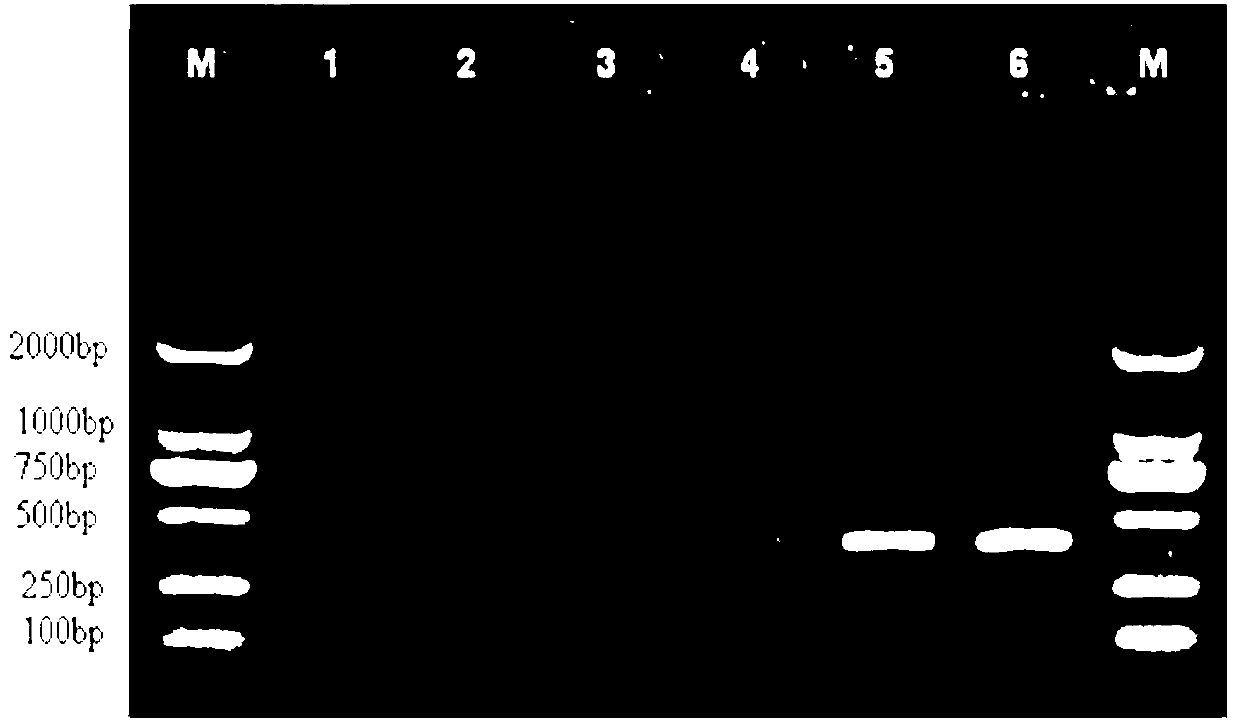Processing method and detecting method for sample of nosema bombycis naegeli in graine by utilizing PCR (Polymerase Chain Reaction) method
A treatment method and detection method technology, applied in the field of microbial detection, can solve the problems of time-consuming and other problems, and achieve the effect of simple operation and low cost
- Summary
- Abstract
- Description
- Claims
- Application Information
AI Technical Summary
Problems solved by technology
Method used
Image
Examples
Embodiment 1
[0034] Example 1 Detection of Silkworm Eggs Infected with Microsoma Bombyx mori
[0035] (1) Primer design
[0036] For the small subunit ribosomal RNA gene (N bombycis SSU rRNAFJ854546.1) of Bombyx mori, specific primers were designed, and the length of the amplified fragment was 408bp, wherein:
[0037] Forward primer (NB-SSU599F): 5'-ATAAATCGGAGGGCAAAT-3';
[0038] Reverse primer (NB-SSU599R): 5'-TAAGCCGCACAATCCAC-3'.
[0039] (2) Sample preparation and processing
[0040] Preparation of the second-generation silkworm eggs infected with M. silkworm: routinely raise silkworm eggs, and after the 5th instar silkworms are raised, carry out different spore concentrations of M. 3 、10 4 、10 5 、10 6 and 10 7 moths / mL) were licked and eaten within 4 hours, followed by routine feeding, stacking, eclosion, mating (the male moths used for mating were healthy individuals) and oviposition, and the eggs laid after mating were the second-generation silkworms. Eggs, pickling the sil...
Embodiment 2
[0057] Example 2 Detection of Healthy Silkworm Eggs Mixed with Bombyx mori Microspores Spores
[0058] (1) Primer design
[0059] Primer design was the same as step (1) in Example 1. .
[0060] (2) Sample processing
[0061] Put healthy silkworm eggs (eggs immediately soaked in pickling, refrigerated eggs soaked in pickling, polymorphic silkworm eggs or naturally aged silkworm eggs) in an incubator at 25°C and a relative humidity of 80% for 10 days , take silkworm eggs that are green or turn blue, put them into a PCR tube, add 5 μL sample pretreatment solution (containing 1mol / L sodium hydroxide and 5mol / L betaine), cover them, place them at 25°C for more than 30 minutes, and use 50 μL Crush the silkworm eggs with the tip of a pipette, and add 1.0 μL of M. silkworm spore liquid. The concentration of M. silkworm spores is 10 5 、10 7 and 10 9 To each / mL, add 5.0 μL of 1.0mol / L hydrochloric acid, cover and place for PCR amplification, and use it up on the same day.
[0062...
Embodiment 3
[0067] Example 3 Detection of Bombyx mori microspores in dead eggs
[0068] (1) Primer design
[0069] Primer design was the same as step (1) in Example 1.
[0070] (2) Sample preparation and processing
[0071] The silkworm eggs were reared conventionally. After the silkworms were raised at the 5th instar, they were licked according to the dose of 100 μL Bombyx mori spore liquid per silkworm. The concentration of Bombyx mori spores was 10 4 Each / mL, eat up within 4 hours, then carry out routine feeding, stacking, eclosion, mating (the male moth used for mating is a healthy individual) and oviposition, and the eggs laid after mating are the second generation silkworm eggs.
[0072] Immediately dip the second-generation silkworm eggs in acid and routinely accelerate greening until they turn green, pick out 10 dead eggs, and the egg prints of the dead eggs are triangular, put them into PCR tubes, put one in each PCR tube, and add 5 μL of sample pretreatment solution (containi...
PUM
 Login to View More
Login to View More Abstract
Description
Claims
Application Information
 Login to View More
Login to View More - Generate Ideas
- Intellectual Property
- Life Sciences
- Materials
- Tech Scout
- Unparalleled Data Quality
- Higher Quality Content
- 60% Fewer Hallucinations
Browse by: Latest US Patents, China's latest patents, Technical Efficacy Thesaurus, Application Domain, Technology Topic, Popular Technical Reports.
© 2025 PatSnap. All rights reserved.Legal|Privacy policy|Modern Slavery Act Transparency Statement|Sitemap|About US| Contact US: help@patsnap.com



